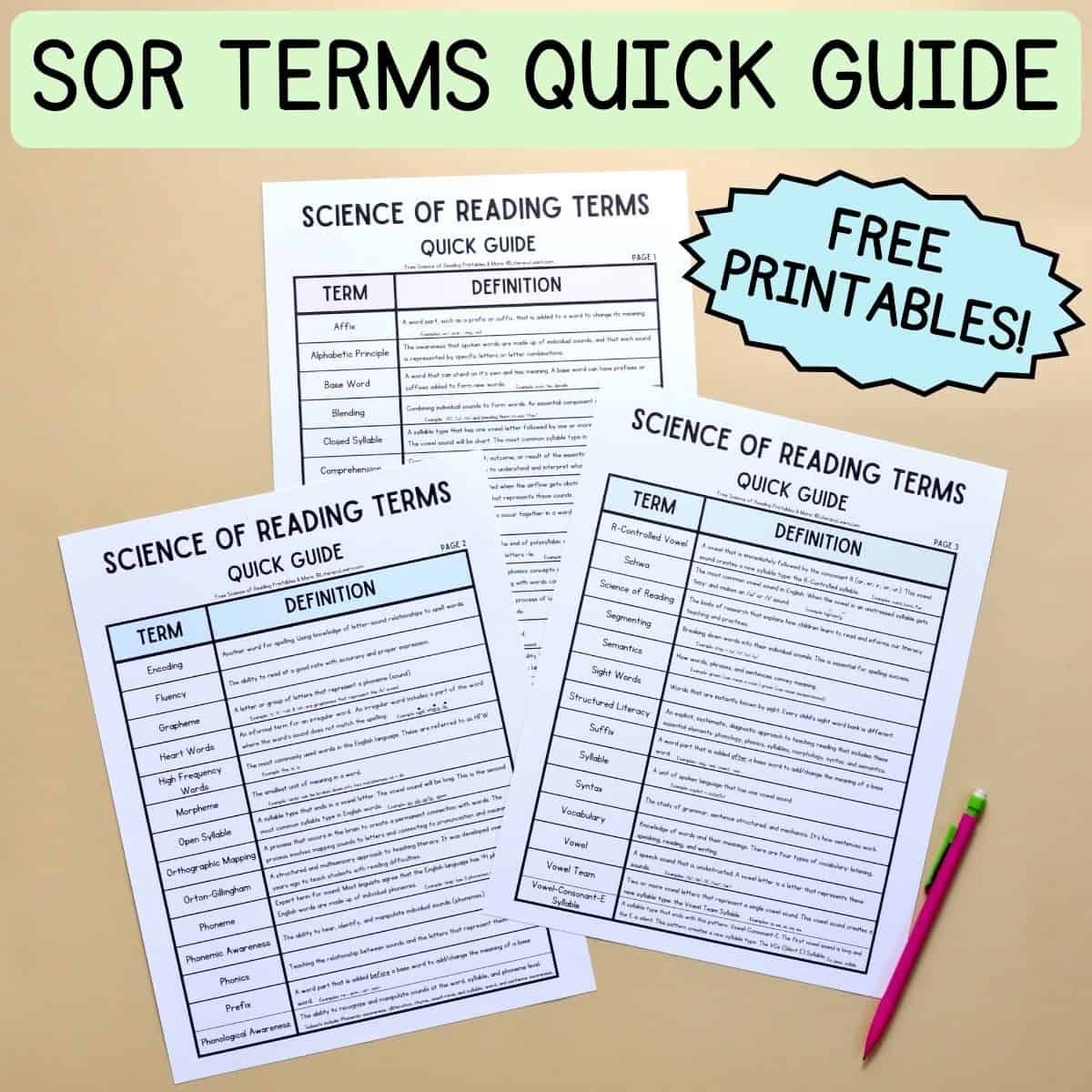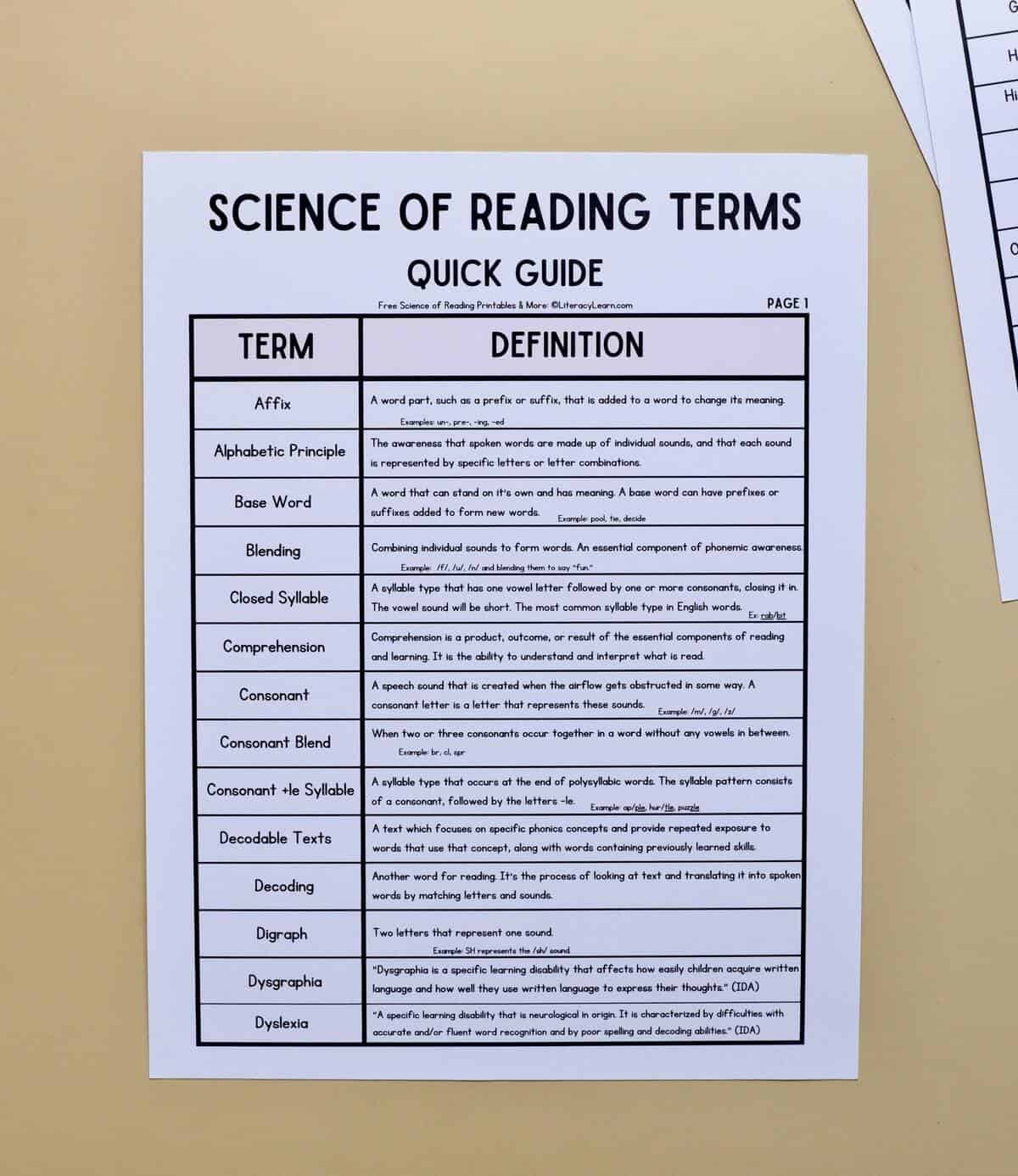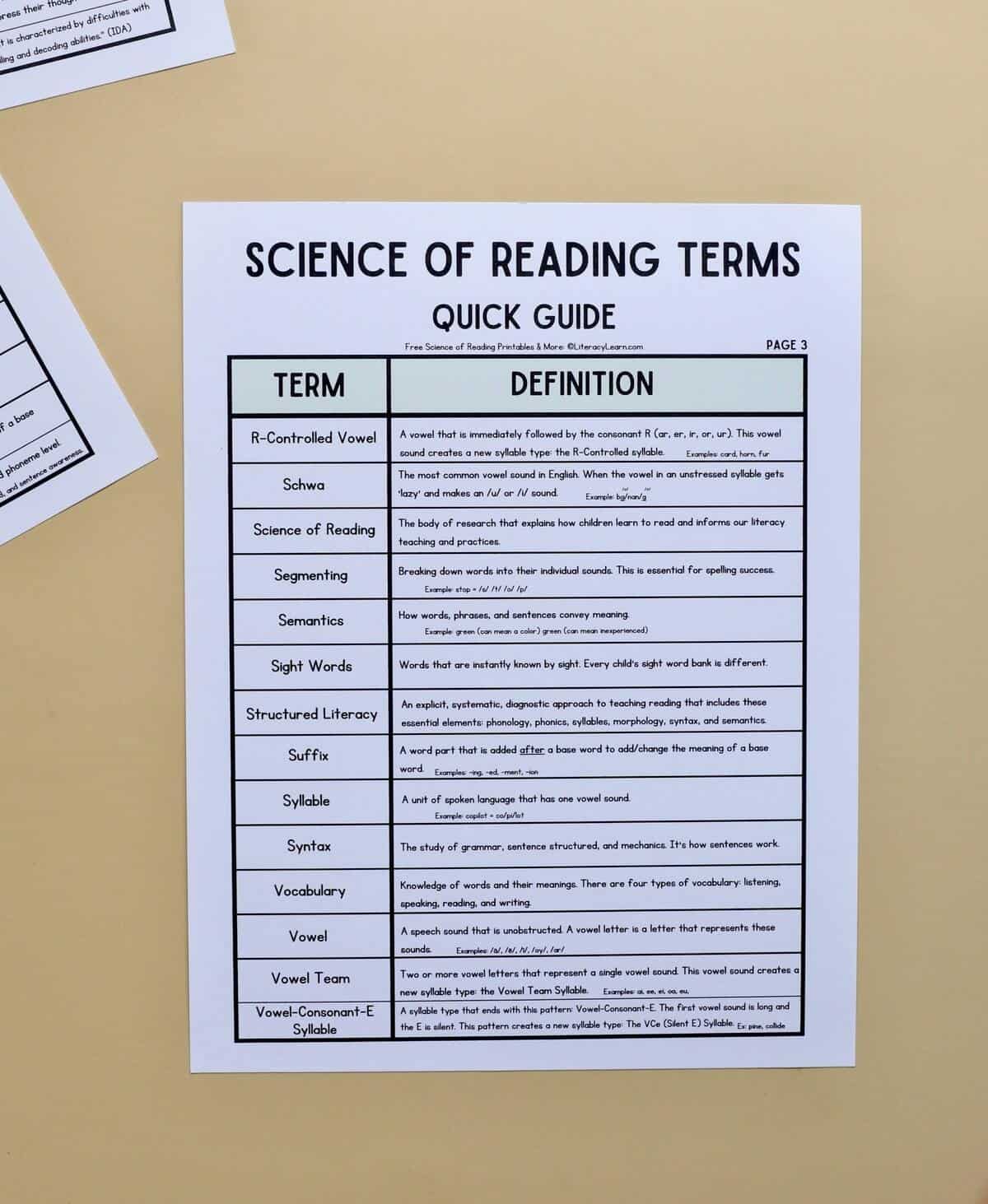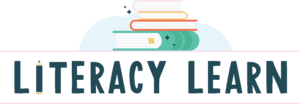Science of Reading Terms: Free Printable Quick Guide
This post may contain affiliate links. As an Amazon affiliate, we earn from qualifying purchases.
Get this FREE 3-page printable Science of Reading Quick Guide with all the terms you need to know. It’s made for teachers and parents and filled with easy-to-understand definitions and examples!

💚 Why We Love It
The Science of Reading (SOR) Quick Guide is a helpful go-to resource for teachers and parents exploring evidence-based reading practices.
This guide helps you get comfortable with important concepts, making it easier to dive into effective reading instruction!
It simplifies 42 of the most essential terms related to Science of Reading, giving clear definitions and examples, so no one has to feel lost or overwhelmed.
Plus, it’s all in one handy place! Instead of searching around for explanations, you can easily look up or reference different terms any time.
With simple language and relatable examples, it’s the perfect introductory guide for learning more about important concepts related to the Science of Reading.
👩🏽🏫 Science of Reading Terms to Know
Below we’ve listed out the 42 Science of Reading terms to know that are included in the guide. There are links to lots of informational posts, freebies, and other resources we’ve created!
Our goal is that you’ll learn AND have the resources you need to align your teaching practices with the Science of Reading.
So let’s get to it!
➡️ Affix: A word part, such as a prefix or suffix, that is added to a word to change its meaning. Examples: un-, pre-, -s, -ing, -ed.
➡️ Alphabetic Principle: The awareness that spoken words are made up of individual sounds, and that each sound is represented by specific letters or letter combinations.
➡️ Base Word: The core part of a word that carries meaning. A base word can have prefixes or suffixes added to form new words. Examples: pool, tie, decide
- Many English words include Greek bases or Latin bases.
➡️ Blending: Combining individual sounds to form words. Blending is an essential component of phonemic awareness. Example: /f/, /u/, /n/ and blending them to say “fun.”
- Activities for teaching blending: Blending board, blending sounds worksheets, continuous blending activity.
➡️ Closed Syllable: A syllable type that has one vowel letter followed by one or more consonants, closing it in. The vowel sound will be short. Closed syllables are the most common syllable type in English words.
- Helpful resources for closed syllables: closed syllable notebook, closed syllable word list.
➡️ Comprehension: Comprehension is a product, outcome, or result of the essential components of reading and learning. It is the ability to understand and interpret what is read. It’s the ultimate goal of literacy instruction.
➡️ Consonant: A speech sound that is created when the airflow gets obstructed in some way. A consonant letter is a letter that represents these sounds.
- Dive deeper to and more about consonants.
➡️ Consonant Blend: A sequence of consonant letters where each letter sound is heard and blended together quickly. Examples: r-blends like br, dr, cr and l-blends like fl, gl, and sl.
- Get everything you need to teach consonant blends, including games, and worksheets.
➡️ Consonant +le Syllable: A syllable type that occurs at the end of polysyllabic words. The C+le syllable pattern consists of a consonant, followed by the letters -le. C+Le Words: ap/ple, hur/tle, puz/zle.
➡️ Decodable Texts: A text which focuses on specific phonics concepts and provides repeated exposure to words that use that concept, along with words containing previously learned skills.
- Find links to hundreds of free decodable texts. Dont’ forget to use decodable sentences, too!
➡️ Decoding: Decoding is another word for the reading process. It’s the process of looking at text and translating it into spoken words by matching letters and sounds.
➡️ Digraph: Two letters that represent one sound. Example: SH represents the /sh/ sound.
- Learn more about digraphs and get resources to help you teach: Read & Spell Digraphs, Digraph word lists, and Digraph SH and CH booklets.
➡️ Dysgraphia: “Dysgraphia is a specific learning disability that affects how easily children acquire written language and how well they use written language to express their thoughts.” –IDA
➡️ Dyslexia: “A specific learning disability that is neurological in origin. It is characterized by difficulties with accurate and/or fluent word recognition and by poor spelling and decoding abilities.” –IDA Dyslexia affects about 20% of the population.
- Learn more about dyslexia and get help from our Dyslexia Therapy Group. We offer online therapy for struggling readers and writers!

➡️ Encoding: Encoding is another word for the spelling process. Using knowledge of letter-sound relationships to spell words.
- Use this free spelling inventory to help you pinpoint your students’ encoding skills. Then grab this fun Roll and Write Activity for fun encoding practice.
➡️ Fluency: The ability to read at a good rate with accuracy and proper expression.
➡️ Grapheme: A letter or group of letters that represent a phoneme (sound). Example: ‘c’ ‘k’ ‘-ck’ & ‘ch’ are graphemes that represent the /k/ sound.
➡️ Heart Word: An informal term for an irregular word. An irregular word includes a part of the word where the word’s sound does not match the spelling. Examples: said, where, do.
- Learn more about heart words and get this extensive heart word resource complete with printable flashcards, a reusable mapping sheet, and Google slides for practice.
➡️ High Frequency Words: The most commonly used words in the English language. These words are referred to as HFW. Because they are so common, teachers must teach HFWs. Examples: the, is, a.
➡️ Morpheme: The smallest unit of meaning in a word. Example: ‘undo’ can be broken down using a word sum into two morphemes: un + do. Morphology instruction is an essential component to structured literacy.
- Grab this helpful morphology word card resource.
➡️ Open Syllable: A syllable type that ends in a vowel letter. The vowel sound will be long. An open syllable is the second most common syllable type in English words. Examples: go, ski, so/lo, o/pen.
➡️ Orthographic Mapping (OM): A process that occurs in the brain to create a permanent connection with words. The OM process involves mapping sounds to letters and connecting them to pronunciation and meaning.
- Elkonin boxes are a great way to promote Orthographic Mapping. Get sound boxes and practice worksheets in our popular bundle and get these amazing phoneme-grapheme mapping worksheets, too!
➡️ Orton-Gillingham (OG): A structured and multisensory approach to teaching literacy. OG was developed over 100 years ago to teach students with reading difficulties.
➡️ Phoneme: Expert term for sound. Most linguists agree that the English language has 44 phonemes. All English words are made up of individual phonemes. Example: ‘ship’ has 3 phonemes = /sh/ /i/ /p/.
- Learn all about phonemes, graphemes, and morphemes in our informative post.
➡️ Phonemic Awareness: The ability to hear, identify, and manipulate individual sounds (phonemes) in words.
- Research says that phonemic awareness instruction with letters is most effective. Get our no-prep resource for phoneme substitution, which includes the important connection to letters.
➡️ Phonics: Teaching the relationship between sounds and the letters that represent them.
- Grab one of our popular phonics game bundles, including fun holiday-themed Roll & Read games.
➡️ Prefix: A word part that is added before a base word to add/change the meaning of a base word. Examples: re-, pre-, un-, non-.
➡️ Phonological Awareness: The ability to recognize and manipulate sounds at the word, syllable, and phoneme level.
Subsets include: Phonemic awareness, alliteration, rhyme, onset-rime, and syllable, word, and sentence awareness.

➡️ R-Controlled Vowel: A vowel that is immediately followed by the consonant R (ar, er, ir, or, ur). This vowel sound creates a new syllable type: the R-Controlled syllable. Examples: card, horn, fur.
- Grab tons of r-controlled (bossy R) resources!
➡️ Schwa: The schwa is the most common vowel sound in English. When the vowel in an unstressed syllable gets ‘lazy’ and makes a short /u/ or /i/ sound.
- Get free printable schwa word lists and schwa practice sheets.
➡️ Science of Reading: The body of research that explains how children learn to read and informs our literacy teaching and practices.
➡️ Segmenting: Breaking down words into their individual sounds. This is essential for spelling success. Example: stop = /s/ /t/ /o/ /p/.
➡️ Semantics: How words, phrases, and sentences convey meaning. Example: Green can mean a color and green can mean inexperienced.
➡️ Sight Words: Words that are instantly known by sight. Every child’s sight word bank is different.
- Read about a SOR-aligned way to teach the most common HFW from the Dolch Sight Word list.
➡️ Structured Literacy: An explicit, systematic, diagnostic approach to teaching reading that includes these essential elements: phonology, phonics, syllables, morphology, syntax, and semantics.
Structured literacy instruction is essential for kids, particularly those with reading and writing challenges.
➡️ Suffix: A word part that is added after a base word to add/change the meaning of a base word. Examples: -ing, -ed, -ment, -ion.
- Grab our extensive resources for teaching the two most common suffixes: suffix -ed and suffix -s and -es.
➡️ Syllable: A unit of spoken language that has one vowel sound. Example: copilot = co/pi/lot
- There are six syllable types in English. Check out our syllable types bundle with worksheets, anchor charts, and visuals.

➡️ Syntax: The study of grammar, sentence structured, and mechanics. It’s how sentences work.
- Sentence scrambling is a great way to practice syntax. You’ll love our FREE r-controllled anagram worksheet or the full decodable sentence scrambling resource!
➡️ Vocabulary: Knowledge of words and their meanings. There are four types of vocabulary: listening, speaking, reading, and writing.
➡️ Vowel: A speech sound that is unobstructed. A vowel letter is a letter that represents these sounds. Examples: /ă/, /ē/, /ĭ/, /oy/, /ar/.
- Get long and short vowel words lists with 1600 words!
➡️ Vowel Team: Two or more vowel letters that represent a single vowel sound. This vowel sound creates a new syllable type: the Vowel Team Syllable. Examples: ai, ee, ei, oa, eu, ow.
➡️ Vowel-Consonant-E Syllable: A syllable type that ends with this pattern: Vowel-Consonant-E. The first vowel sound is long and the E is silent. This pattern creates a new syllable type: The VCe (Silent E) Syllable. These are sometimes called magic E words. Examples: pine, collide.
🖨 Download & Print
Please let us know how you’re using this SOR guide! Comment below!
DOWNLOAD TERMS: All of our resources and printables are designed for personal use only in homes and classrooms. Each teacher must download his or her own copy. You may not: Save our files to a shared drive, reproduce our resources on the web, or make photocopies for anyone besides your own students. To share with others, please use the social share links provided or distribute the link to the blog post so others can download their own copies. Your support in this allows us to keep making free resources for everyone! Please see our Creative Credits page for information about the licensed clipart we use. If you have any questions or concerns regarding our terms, please email us. Thank you!



Thank you
Hi Sarah, You are so welcome! 🙂 Let us know if you find this resource helpful! -Katie & Laura